In this article, you’ll learn proven, practical objection-handling strategies you can use in your business development tactics.
Table of Contents
- What is a sales objection?
- What is objection handling?
- Types of Sales Objections
- How to Overcome Sales Objections
- Common Sales Objections
- Handling Objections
- Objection Handling Training
- When an Objection is a Firm “No”
What is a sales objection?
A sales objection is any concern a prospect raises in reference to a barrier obstructing their ability to buy from you – an explicit indication that you have to address more aspects of the buying process than you initially anticipated.
A typical sales objection arises when a prospect has a perceived or actual lack of specific resources. Prospects usually object to a sale when they feel they don’t have the money, interest, need, or autonomy to buy from your business.
My experiences taught me that prospects are reluctant to speak with a sales rep if they:
- Don’t have a defined mandate or the authority to engage with a salesperson’s offer.
- Don’t feel they are prepared or educated enough on a topic to have a meaningful conversation.
- Have had negative experiences with salespeople in the past, with your company, or otherwise.
- Feel overwhelmed if a seller’s pitch is full of technical jargon or industry-speak.
- Are reluctant to get into a high-pressure, prolonged sales process with an unfamiliar (or even a familiar) company or representative.
- Work in a matrixed organization with complex or rigid buying and approval processes.
- Have real or misconceived concerns about the cost, commitment, or inflexibility of your company and its solutions.
- Are skeptical your solution can deliver the value you describe in your pitch or promotional material.
While sales objections present some daunting obstacles to a sales process, overcoming objections in sales is possible with practice and proven strategies.
What is objection handling?
Objection handling is when a prospect presents a concern about the product/service a salesperson is selling, and the salesperson responds in a way that alleviates those concerns and allows the deal to move forward. Objections are generally around price, product fit, or competitors. Sometimes, the objection is a good old-fashioned brush-off.
Handling Objections
Handling objections is an inevitable and often challenging task for sales pros. According to HubSpot data, sellers who successfully defend their product against buyers' objections can have a close rate as high as 64%.
Underachieving sales reps respond to prospect objections by:
- Conceding defeat immediately and disengaging from the prospect.
- Arguing their case defensively without probing for the source of an objection.
- Trying to pressure the prospect into remaining engaged by sowing fear, uncertainty, and doubt (FUD).
- Making derogatory statements about competitors the prospect has (or is considering) a relationship with.
- Using tired transactional sales tactics like offering discounts or making false claims instead of taking a consultative sales approach.
These kinds of aggressive selling approaches aren’t effective at handling objections.
Prospects often feel these kinds of responses justify their attitude about your company, or sales people in general. Using these tactics can undermine any trust or rapport you’ve developed with a customer or prospect, and anyone they share their experiences with.
In contrast, proper handling of objections in sales demands that a salesperson:
- Demonstrates situational awareness.
- Gathers or accrues background information throughout the sales process.
- Leads with empathy.
- Asks thoughtful, open-ended questions.
- Treads carefully when the prospect isn’t correct.
Next, I’ll break these items down a little and add some context.
Have situational awareness.
There isn’t a single cure-all objection handling formula. Instead, you need to develop instincts for where you are in your sales process, the nature of the deal you’re pursuing, and your prospect’s needs and interests.
Understanding the circumstances that are shaping a prospect’s objections is central to addressing them effectively.
In my experience: I’ve learned from making situational awareness mistakes a couple of times. Once I admitted to a customer that I had been so busy pursuing other opportunities that I hadn’t checked in with them in a while. The customer responded saying their feelings were hurt that I deprioritized them. I focused more on my account farming responsibilities after that conversation.
Gather extensive background information.
This point is a natural extension of the one above. Gathering background information informs effective, actionable situational awareness. Thoroughly research your prospect's company and, to a certain extent, the specific prospect or client.
See if you can answer the following:
- What challenges is the customer or prospect currently facing?
- What are the prospect’s near- and long-term goals?
- What issues do the prospect‘s industry peers encounter?
- What is their decision-making authority?
- What aspects of the company's operations do they work with on a day-to-day basis?
- What obstacles and restrictions does someone in their position typically encounter?
Uncovering these background insights can put you in a better position to handle objections tactfully.
In my experience: As I described earlier, I discovered the hard way that customers need to be consistently reminded of how much you value their business through regular follow-up. Your other business activities aren’t material to their needs.
Lead with empathy.
Empathy is central to every successful sales effort. You likely didn’t get into sales purely entirely earning commission or meeting or exceeding quota. The best salespeople I worked with loved to help businesses solve problems with the products and services they helped the customer gain access to.
Always bear a client’s needs and interests in mind, and they will often respond with trust, signed contracts — and best-case — become an advocate for your business through testimonials and success stories.
Ask thoughtful, open-ended questions.
The ability to ask thoughtful, open-ended questions can underscore every other point listed here. You need to get to the root of your prospect’s pain points if you’re going to understand and effectively handle the objections they raise.
Avoid questions that only warrant “yes or no” answers — and don't be afraid to use silence to your advantage. Also, let your buyers air their thoughts out. Feel out their concerns and put yourself in a position to overcome objections they might raise with calm confidence.
When the customer isn’t right, tread lightly.
Telling a prospect their objection isn’t justified can derail a relationship quickly. Instead, acknowledge their objection, then explain how doing business with you would actually look.
It's also important to distinguish between sales objections and brush-offs. While objections are authentic, brush-offs are excuses. Think of an objection as, “I see the value in your product, but I'm not sure about buying it for X reason,” while a brush-off translates to, “I don't want to talk to you.”
Unstated objections are far more serious than brush-offs. If you don’t know why a prospect doesn’t trust you or value what you have to offer, you are wasting your time and theirs.
In my experience: I once had the IT manager of a local government tell me they would never do business with my company (a large Canadian telco). When pressed, he said he felt my company was too big to offer his organization personalized service. Fortunately, I had testimonials from the prospect’s peers across the country who had similar reservations at first, but were pleasantly surprised at our ability to meet their needs. That reassured the prospect, and I landed his business.
Pro tip: Keep a list of customer success stories, testimonials, or third-party data that addresses common objections like cost, flexibility, or return on investment. Share authentic, quantifiable examples of the impact of your company’s products and services.
Objection Handling Framework
A proven and effective method for objection handling is Carew International’s LAER: The Bonding Process®. LAER involves four steps — Listen, Acknowledge, Explore, and Respond — and creates a positive, two-way transaction between the salesperson and the customer.
I’ll break down each step along with insights from sales leaders I talked to.
Step 1: Anticipate
Before you start with the LAER process, the first step is to anticipate objections by preparing for the conversation.
Laura Youngblom, president and chief revenue officer at Sell It, suggests “by consistently preparing for potential objections, you will learn more about your customers and what’s holding them back and eventually be able to predict what their objections will be.”
If you did your homework, you can address the objection factually, offer some context to allay their concerns, and enable you both to proceed with confidence.
Step 2: Listen
When confronted with an objection, the first requirement is to actively listen to it. Listening demonstrates to your customer that you are interested in their concern and care about what they have to say.
“The adage ‘people buy from those they know, like, and trust’ is still true. Buyers want (and expect) a personalized sales experience. How you present yourself and your product either builds that trust — or gives your competitors a foot in the door,” comments Mark Tanner, co-founder of Qwilr.
Step 3: Acknowledge
The next step is to acknowledge your customer’s concern. This is where you demonstrate you have been actively listening. Acknowledging and validating an objection can be as simple as a head nod or a restatement of the issue as you understand it. A sincere acknowledgment can build trust and have a calming effect. Sometimes, your customers just want to know that they are being heard.
“Not pretending you have all the answers and being genuine in communicating when you don't know something helps build trusting and reliable relationships,” says Sami Malik, CEO of Linear Health, a founder-led sales expert.
Youngblom adds that “when you disagree, you stop the flow of communication, but when you agree, their defenses come down.”
Step 4: Explore
The third step is to explore the concerns underlying your customer’s objection. It's imperative that you understand exactly what your customers meant by what they said.
For example, your customer may raise a price objection. Take the time to explore the customer’s objection, and you may discover they are using price as a smokescreen for fears of putting their own reputation on the line.
In my experience: I once had a customer who expressed an interest in integrating my company’s document management software (which they had deployed) and their ERP software. However, we hit a roadblock when my customer objected to our acquisition process because of RFP requirements on his end.
Fortunately, because I was able to uncover the details of the roadblock by active listening and exhibiting empathy, I was also able to come up with a solution and ultimately make the sale.
Step 5: Respond
The final step is to respond. Only once you have a complete understanding of your customer’s objection can you effectively respond with a credible:
- Counterargument of how your company can exceed their expectations and deliver measurable value.
- Product or service recommendation.
- Business proposal that specifically addresses the customer’s concerns and closes the transaction.
Objection handling doesn’t have to be a painful activity for salespeople. Instead, objections should be viewed as opportunities to help your customer and grow your relationship with them.
Why is objection handling important?
Nothing is more dangerous to a deal than letting sales objections go unaddressed until the final stages. When a prospect’s objection goes unaddressed (whether warranted or not), it grows stronger and becomes deep-rooted, making it harder to overcome it.
With this in mind, don’t avoid objections — welcome them. You can proactively find them as well by periodically asking questions like:
- “Do you have any concerns about X?”
- “Can you see your team making X part of their daily routine?”
- “Is X a strategic business goal for your company this year?”
- “Are there any obstacles that would stop you from buying X?”
- “How confident do you feel you'd see success from [product]? Why?”
- “You seem a little worried about X. What are your thoughts?”
- “What do you think will happen if X problem doesn’t get addressed over the next few months?”
Types of Sales Objections
- Lack of Budget
- Lack of Trust
- Lack of Need
- Lack of Urgency
As I touched on at the beginning of this article, most sales objections stem from some kind of “lack” — and they typically come from a reasonable place. Prospects who raise objections generally point to the fact that they simply can't buy right now.
But those “lacks” are often misplaced, and if you know what you‘re doing, you can usually find ways to work around them. Let’s take a closer look at some of the most common types of objections in sales.
1. Lack of Budget
“It's too expensive.”
Objections based on price are the ones you‘ll come across most frequently. That’s because all purchases come with some level of financial risk.
As a sales rep, you'll want to consider the positioning of your product or service and how to demonstrate that value. This turns the conversation into one about risk vs. reward.
By providing value and painting a picture of where your solution will take them, they can be convinced that the reward is enough to justify the risk.
2. Lack of Trust
“I've never heard of your company.”
People do business with people they like, know, and trust.
In an inbound sales conversation, the prospect will have likely interacted with your content or will already be familiar with your organization in some way. This objection could be overcome by jogging their memory, or you might consider your sales cycle and whether it's feasible to nurture them through it.
But not all conversations are inbound conversations, and they may have genuinely never heard of you. It's at this point that you double down on the value you provide with your elevator pitch. Be sure to emphasize the authority your organization has in the market, and share examples of the companies you’ve worked with to gain credibility.
3. Lack of Need
“I don't see how this can help me.”
This may seem like an objection on the surface, but it's actually an opportunity to give information to the prospect (and get information from them in return). Use open-ended and layered questions to qualify the prospect and evaluate their needs. If you find a fit, leverage it to demonstrate value.
4. Lack of Urgency
“[X problem] isn't important for me right now.”
The goal here is to figure out if timing actually is an issue or if the prospect is brushing you off. One way to do that is by asking them to elaborate on why it's not important or what competing priorities currently have their attention.
Listen closely to determine if their response involves concrete timing issues or vague excuses. If they're doing backflips to justify inaction on a real pain point, you may have an opening.
When all else fails, try and schedule an appointment with them at a later date to dive deeper into the issue.
How to Overcome Sales Objections
- Practice active listening.
- Repeat back what you hear.
- Validate your prospect’s concerns.
- Ask follow-up questions.
- Leverage social proof.
- Set a specific date and time to follow up.
- Anticipate sales objections.
When trying to overcome sales objectives, it’s imperative you respond appropriately and avoid reacting impulsively to your prospect’s objections. Here are some helpful strategies for overcoming objections.
1. Practice active listening.
First and foremost, as your prospect is sharing their concerns with you, make sure you are using active listening skills to take in what they’re saying.
While your prospect discloses their objections, listen to understand, not respond. Avoid interrupting them while they are speaking, and give them space to voice their concerns and objections freely.
2. Repeat back what you hear.
Once your prospect has stated their objections, repeat back what you heard to make sure you are understanding correctly. Not only will this help clarify their points for you, but it will also help your prospect feel heard and valued, which is important for building trust.
3. Validate your prospect’s concerns.
After you have confirmed you understand where your prospect is coming from, continue building trust by empathizing with your prospect and validating their point of view. No, that doesn’t mean you have to talk down on your product or recommend a competitor.
For example, if you are selling automation software and your prospect is worried about their ability to implement your software into their complex system, you could say, “I understand. Implementing new software can feel like a daunting task. Thankfully, we have an incredible tech team that has experience working with similar organizations and can handle a seamless transition for you.”
With this response, you acknowledge that their concern is valid and offer a solution to mitigate their fears.
4. Ask follow-up questions.
When you hear objectives, you want to do all you can to keep the conversation going in a natural way. If you hear your prospect pulling back, asking follow-up questions can be a tactful way to keep them talking.
Don’t ask questions that can be answered with a simple “yes” or “no.” Make sure you ask open-ended questions that allow your prospect to continue expressing their thoughts on your product. The more information they give, the more you have to work with.
5. Leverage social proof.
Depending on the nature of your prospect’s concern, sharing the story of another customer who had similar reservations and went on to see success with your product can be a successful approach.
If you are in B2B sales, you can also share relevant information about your prospect’s competitors and any success they’ve seen from overcoming a similar objection.
6. Set a specific date and time to follow up.
If your prospect asks for more time to think things over, give them the time and space to weigh their options. But you don’t want to leave them hanging. Set up a specific time and date to follow up in the near future so too much time doesn’t pass, and offer to answer any questions they have in the meantime as they deliberate.
7. Anticipate sales objections.
Ultimately, the most effective strategy for handling sales objections is to predict them. When you are prepared to have objections come up, you’re far less likely to be thrown off your game.
Keeping track of the objections you receive most often is also helpful. Once you know what to expect, you can devote extra time to practicing and refining your responses.
We also recommend sales reps use role-playing to boost their objection-handling abilities. Take turns with another rep on your team posing common objections (like any on the list below), answering, and then giving each other feedback.
Common Sales Objections
- It's too expensive.
- We don’t have the funds for this.
- We don't have any budget left.
- I need to use this budget somewhere else.
- I don't want to get locked into a long-term a contract.
- We're already working with [Vendor X].
- I'm locked into a contract with a competitor.
- I can get a cheaper version somewhere else.
- I'm happy with [Competitor X].
- Competitor X says [false statement about your product].
- I'm not authorized to sign off on this purchase.
- I can't sell this internally.
- [Economic buyer] isn't convinced.
- We're being downsized/bought out.
- There's too much going on right now.
- I'm part of a buying group.
- I've never heard of your company.
- We're doing great in X area.
- Our business doesn’t experience the challenges you describe.
- X problem isn’t important right now.
- I don't see what your product could do for me.
- I don't understand your product.
- I've heard complaints about you from [company].
- We don't have the capacity to implement the product.
- Your product is just too complicated.
- You don't understand my challenges. I need help with Y, not X.
- You don't understand my business.
- Your product doesn't have X feature, and we need it.
- We're happy the way things are.
- I don't see the potential for ROI.
- X is just a fad.
- Your product doesn't work with our current [tools, set-up].
- Your product sounds great, but I'm too swamped right now to handle [implementation, rollout, etc.].
- *Click*
- I'm busy right now.
- I'm not interested.
- Just send me some information.
- Call me back next quarter.
- How did you get my information?
- I hate you.
- I'm not responsible for making these decisions.
- Does your product do X, Y, and Z?
- Sorry, I have to cancel. I'll get back to you with a better time.
- Hello, you've reached [Prospect's Name] ...
“No” is something salespeople hear often. In fact, 60% of customers say no four times before they say yes. Objections vary by business scale, industry, and what you're selling. But, knowing and preparing for the most common objections can help you close more sales.
The answers below can help you respond to the objections you're most likely to hear on your first few calls with a prospect. But, the most effective way to handle objections is to craft your own responses.
So, if you're looking for a quick and easy way to get started, check out this sales objections and answers PDF. It has useful templates to jumpstart your personalized objection responses.
Sales Objections About Price and Budget
1. “It's too expensive.”
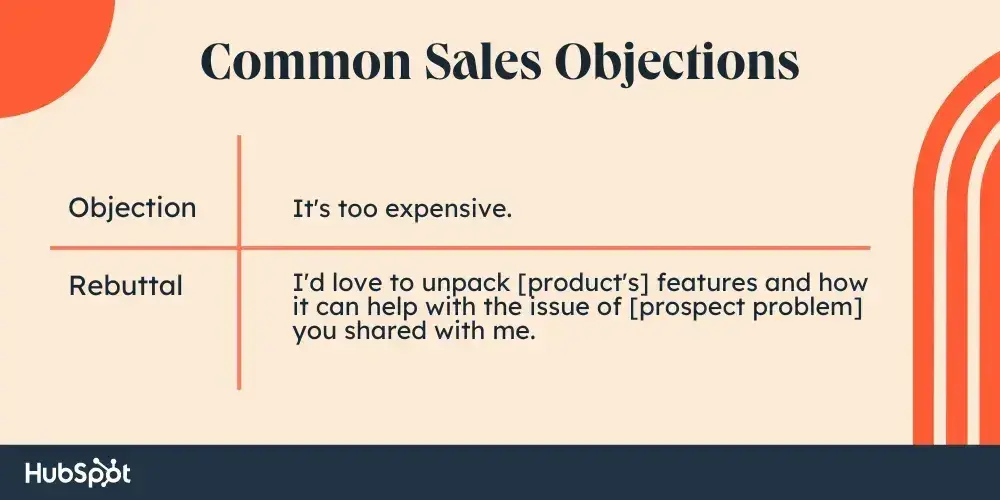
Price objections are the most common type of objection and are even voiced by prospects who have every intention of buying. Beware — the moment you start focusing on price as a selling point, you reduce yourself to a transactional middleman. Instead, circle back to the product's value.
Try responding this way:
“I‘d love to unpack [product’s] features and how it can help with the issue of [prospect problem] you shared with me. I can also share a case study of how another business in your industry [realized measurable ROI]”
2. “We don’t have the funds for this.”
It could be that your prospect‘s business simply isn’t big enough or generating enough cash right now to afford a product like yours. If the prospect has a strategic long-term upside offer to keep in touch. Monitor their growth and see how you can help your prospect get to a place where your offering would fit into their business.
Your company may have alternative financing, subscription tiers, or phased implementation models that may put your products or services in reach. A small-scale purchase may not be significant this quarter, but
Try responding this way:
“I understand. Allow me to explain our other offerings that may be a better fit for your current growth levels and budget.”
3. “We don't have any budget left this year.”
A variation of the “no money” objection, what your prospect’s telling you here is that they’re having cash flow issues. But if there's a pressing problem, it needs to get solved eventually. Either help your prospect secure a budget from executives to buy now or arrange a follow-up call for early in their next fiscal cycle when funds are being allocated.
Try responding this way:
“Let's schedule a follow-up call for when you expect funding to return. When do you think that may be?”
4. “We need to use that budget somewhere else.”
Prospects sometimes try to earmark resources for other uses. It's your job to make your product/service a priority that deserves budget allocation now. Share case studies of similar companies that have saved money, increased efficiency, or had a massive ROI with you.
Try responding this way:
“We had a customer with a similar issue, but by purchasing [product], they were actually able to increase their ROI and assign some of their new revenue to other parts of the budget.”
5. “I don't want to get locked into a long-term contract.”
A prospect with a genuine need and interest who balks at time-based contract terms is generally hesitant for cash flow reasons. In many cases, there are workarounds — find out if you can offer month-by-month or quarter-by-quarter payment instead of asking for a year or more commitment upfront.
Try responding this way:
“I understand. Let's talk about some different contract terms and payment schedules that I can offer you. Perhaps these would be a better fit.”
Sales Objections About the Competition
6. “We're already discussing this project with [Vendor X].”

A prospect who’s already working with a competitor can be a gift. They’ve already recognized a need and identified a solution; much of the education you’d otherwise be responsible for has already been done. You can spend your time doing the one thing you’d have to hold off on with a prospect who hasn't recognized their pain yet — talk about your product.
Just because a prospect is working with a competitor doesn’t mean they’re happy with them. Probe into the relationship and pay special attention to complaints that could be solved with your product. Resist the urge to disparage the competitor. Instead, highlight your company’s strengths, product advantages, and service differentiators. Don’t say anything that could be damaging to your company’s reputation if it got back to the competitor. Be factual and respectful.
Try responding this way:
“Why did you choose [vendor]? What‘s working well? What’s not? Allow me to explain how [product] is different.”
7. “I'm locked into a contract with a competitor.”
This objection often seems like a deal-killer, but can be overcome if your sales leadership team is empowered to offer competitive upgrades. This objection is worded in a way that indicates your prospect's feeling of being trapped. See if you can come up with a creative discount to offset the cost of breaking a contract early, or demonstrate ROI that will make up for the sunk cost.
Of course, your prospect could have simply chosen an overly negative turn of phrase. Ask questions about their relationship with the competitor to determine whether they're actually happy or are itching for a vendor switch.
Try responding this way:
“How is your relationship with [competitor]? I can work with my manager to see if there is a way we can help ease the cost and effort involved to upgrading to our solution.”
In my experience: In software sales roles, I enjoyed positioning a migration from a competitive solution as an upgrade. Of course, it only worked if I could demonstrate how my solution was uniquely better for the prospect than their existing solution.
8. “I can get a cheaper version of your product somewhere else.”
Find out what you're dealing with here. Are you in a competitive situation, and the prospect is playing you against a competitor to drive up discounts? Or is your prospect under the impression that a similar, cheaper product can do everything they need? I often reminded the prospect of how the old adage “You get what you pay for” is usually true.
If it's the former, lay out your deepest discount and emphasize the features that make your product superior. Walk away if they ask you to go lower. In the second scenario, take advantage of the comparison. Play the differences up and emphasize overall worth, not cost.
Try responding this way:
“What are the points of differentiation between [product] and your other option? What gives you the most value and support?”
9. “I'm happy with [Competitor X].”
What if your prospect is happy? The same strategy still applies — find out why they believe their relationship with your competitor is beneficial, and identify vulnerabilities where you can build a business case for how your offerings can offer more value than their current provider.
Try responding this way:
“That‘s great. What components of the product or relationship are you most satisfied with? I’d love to learn more and see how we compare.”
10. “Competitor X says [false statement about your product].”
According to the creator of Your Sales MBA® Jeff Hoffman, when faced with a false statement from a competitor, salespeople should first respond with, "That's not true," then pause. Be prepared to explain how things really are, but don’t rush to do so. That could show weakness or uncertainty.
Hoffman says this reply will satisfy the buyer about 90% of the time, and they’ll be willing to move on. You’ll seem confident and collected, whereas your competitor will seem desperate and insecure.
If your prospect is still unsure, they'll ask another question. At that point, you can offer more background in your rebuttal.
Try responding this way:
“We manufacture our products in Canada, not Thailand. I have a map of our factories and distribution routes if you'd like to see it.”
Sales Objections About Authority or Ability to Buy
11. “I'm not authorized to sign off on this purchase.”
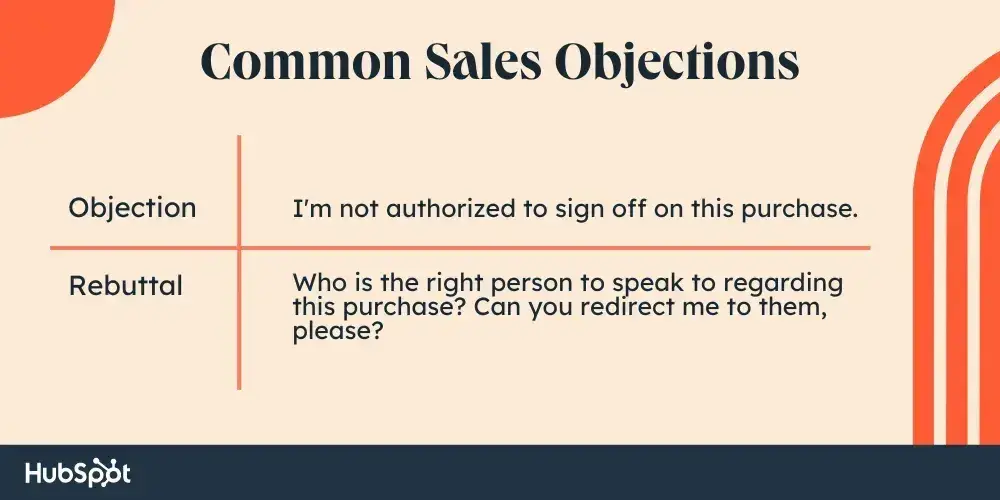
No problem. Ask your prospect the name of the right person to speak to, and then redirect your call to them.
Try responding this way:
“Who is the right person to speak to regarding this purchase? Can you redirect me to them, please?”
12. “I can't sell this internally.”
Well, your prospect might not be able to, but you can. After all, you sell your product every day. Ask your prospect what objections they anticipate, and help them prepare the business case for adopting your product.
I often wrote email and PowerPoint templates that I called “Business case in a box” that described my company’s unique sales proposition, success stories, and campaign offerings in a way that could be shared by my champion influencer. Relying on someone else to be your sales advocate in their own company is far from fool-proof, though, and I preferred to write the messaging to take the pressure off my point of contact.
Try responding this way:
“What objections do you think you'll face? Can I help you prepare the business case for when you speak with your decision-makers? I may have some enablement materials I can share to help.”
13. “[Economic buyer] isn't convinced.”
If you've already addressed objection #12 by providing internal selling advice and coaching, and your prospect can’t win over the decision maker or help you get access, it might be time to walk away. While it’s disappointing to give up on a prospect who’s on your side and just can’t convince the higher-ups, it’s also a waste of your time to keep butting heads with someone who will never see your product’s value.
Try responding this way:
“That‘s too bad. If anything changes, please don’t hesitate to contact me. I'd love to help you get your team onboard.”
14. “We're being downsized/bought out.”
This happens rarely, but there’s usually nothing you can do when a company is enduring a lot of internal turmoil, as buying processes are often postponed indefinitely. Wrap the relationship professionally so that when the dust settles (or the prospect finds a new gig) they’ll be more likely to restart the conversation. Albeit possibly from a new company, mind you.
Try responding this way:
“Thank you for your time and for speaking with me regarding this product. If you‘re ever in need of [product or service], please don’t hesitate to contact me.”
15. “There's too much going on right now.”
Ask your prospect to define their competing priorities for you. If they can’t, it’s likely a brush-off, and you should press them on precisely why they don't want to engage with you.
If they can offer concrete answers, don‘t sweat it. Set a meeting time for a follow-up and send over helpful resources in the meantime to stay on your prospect’s radar. Or, take a bolder step if you can, and be prepared to explain why waiting for next quarter, next month, or next year might cost the customer in the long run. Can they really afford to put off addressing the business need that was the catalyst for the conversation in the first place?
Try responding this way:
“I understand. What are some of your competing priorities? I'd love to schedule a follow-up call for when your calendar clears up.”
16. “I'm part of a buying group.”
Buying groups enable independent companies to team up and make joint purchases from vendors — usually getting a far better price than they'd be able to secure on their own. (I just completed a proposal to qualify for a significant North American buying group, so I know this can be a significant obstacle.)
If your company isn‘t on a prospect’s list of approved suppliers. You may be able to win them over by matching the cost and delivery terms of the buying group contract, but that may erode your profit margins, so be sure to discuss this scenario with your management team.
Respond to this objection by delving into the details of their membership. When you’ve learned more, you can decide whether it makes economic sense for this prospect to work with you — and if there’s an opportunity to become one of their buying group's vendors.
Try responding this way:
“Are there limits on whom you can buy from? What price are you currently receiving? What companies belong to your buying coalition?”
Sales Objections About Need and Fit
17. “I've never heard of your company.”
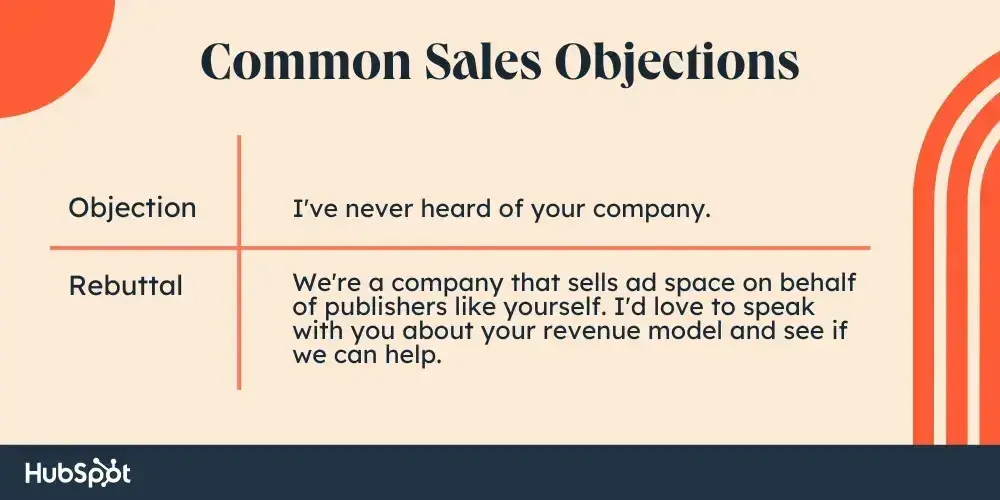
Treat this objection as a request for information. Don't give an elevator pitch, but offer a quick summary of your value proposition.
Try responding this way:
“We‘re a company that sells ad space on behalf of publishers like yourself. I’d love to speak with you about your revenue model and see if we can help.”
18. “We're doing great in X area.”
If you hear this objection, ask a few more clarifying questions and do a little more qualification.
Try responding this way:
“What are your goals? How much progress has been made?”
19. “Our business doesn’t experience the challenges you describe.”
This objection is often raised as a brush-off, or because prospects haven’t realized they’re experiencing a certain problem yet. Ultimately, you might discover they really don’t need your product or service, but don’t take this objection at face value.
Try responding this way:
“Interesting. Do you have any business goals or challenges that you are struggling to address that I might be able to help you with?”
20. “X problem isn't important right now.”
Sometimes, a simple “Oh?” will be enough for your prospect to start talking. Listen closely for real reasons the need has low priority versus platitudes. Keep in mind that excuses can be a sign that your prospect understands they have a problem and is trying to rationalize their inaction. Capitalize on this and instill a sense of urgency.
Try responding this way:
“Tell me more about that. What are your current priorities?”
21. “I don't see what your product could do for me.”
Another request for information packaged as an objection. Reconfirm the goals or challenges you've discussed and explain how your product can solve specific problems.
Try responding this way:
“Interesting. Can you share what specific challenges you're facing right now? Perhaps [product] presents a solution we have yet to discuss.”
22. “I don't understand your product.”
If your prospect literally can’t wrap their head around your product, that’s a bad sign. If your product is particularly complicated or specialized, it may be time to disqualify your prospect, lest they churn two months from now.
Don’t give up immediately, though. Ask your prospect what aspects of your product they’re unclear on, then try explaining it in a different way. Alternatively, bring in a technician or product engineer to answer questions out of your depth. Make sure you aren’t using any business jargon, acronyms, or complex wording that might make your pitch unclear to the uninitiated.
Try responding this way:
“What aspects of the product are confusing to you? I'd love to connect you to a customer success technician or product engineer to help you better understand how we can help you.”
23. “I've heard complaints about you from [company].”
Word-of-mouth reviews are powerful, which can be both a blessing and a curse. Rather than defending your solution, business, or brand — which will only validate the criticism — thank them for sharing the feedback with you. Then, follow up with an offer to add value.
This gives you an opportunity to establish credibility and trust with your prospect. Once you‘ve given them a positive experience, they’ll naturally form a high opinion of you.
Try responding this way:
“Thanks for sharing that feedback with me. I‘ll pass it along to [relevant department]. While we’re on the phone, would you be interested in hearing a few tips for improving your average invoicing turnaround time?”
24. “We don't have the capacity to implement the product.”
This objection can be a deal-killing roadblock. Depending on what product you sell, it’s possible your prospect will have to add headcount or divert resources to fully take advantage of your offering, and if they truly aren’t able to, you might have to disqualify them. Do you have any services that can help them add implementation capacity and help them realize measurable results at costs they can justify without hiring additional staff?
Try responding this way:
“I hear you, and I want [product] to add value, not become a burden. What are your current day-to-day responsibilities in your job? I'd love to explain how [the product], once onboarded, can alleviate some of those problems without requiring additional staff overhead or being a resource drain.”
25. “Your product is too complicated.”
Find out if your prospect is confused about specific features or if the product is indeed over their head. If it’s the latter, you might have to disqualify that lead. But if it’s the former, remind your prospect that they’ll have help from your customer service team should they choose to buy and that you’ll be on hand to answer any implementation questions they have.
Try responding this way:
“What features are confusing to you? Our customer success team can help you tailor the user experience to the way you do business. Our support services will be available around the clock to help with implementation and beyond.”
26. “You don't understand my challenges. I need help with Y, not X.”
It‘s crucial to make your prospect feel heard. Restate your impression of their situation, then align with your prospect’s take and move forward from there. A lot of misunderstandings and hard feelings can be resolved simply by rephrasing your prospect's words.
Try responding this way:
“Sorry I got that wrong. Would you allow me to restate my understanding of your challenges, and correct me again if I'm still missing or misstating anything that’s important to you? I assure you that I will make it worth your time.”
27. “You don't understand my business.”
If you sell to a specific industry, chances are you know a bit about the challenges and priorities your prospect's business is likely faced with. Let them know that you have experience working with similar companies and have solved similar problems in the past.
If you simply made an incorrect assumption about your prospect’s company or industry, don’t be afraid to own up to it. Your prospects will appreciate your candor.
Try responding this way:
“Sorry — I assumed X was true, but it looks like that doesn't apply to your business. Can you tell me a little more about how it works for your business?”
28. “Your product doesn't have X feature, and we need it.”
Try suggesting a supplementary product that can be used in conjunction with yours. But if that specific need is a must-have and your product can't solve it, your prospect might not be a good fit. Time to disqualify and move along to a better-fit opportunity.
Try responding this way:
“Have you checked out [partner or conjoining product]? It's a good fit with ours and can be used alongside it to solve for Y.”
29. “We're happy the way things are.”
Maybe everything really is going swimmingly. But more likely, your prospect is having some sort of challenge (after all, who isn’t?). Do some light qualification to determine if they’re facing any problems you can solve, then move forward or disqualify them based on their answers.
Try responding this way:
“That‘s great! Can you tell me how you’re currently solving for X?”
30. “I don't see the potential for ROI.”
This is a sign that you'll have to prepare a formal pitch for either your contact or their managers, either using internal numbers from your prospect or customer case studies. Nothing sells quite like hard numbers.
Try responding this way:
“I‘d love to show you. Can we schedule a time for me to explain our product’s potential to deliver a high ROI to you and your team?”
31. “X is just a fad.”
You might hear this objection if your product pioneers a concept that’s new to your prospect’s industry. For example, social media is now widely accepted as a necessary part of a sound business strategy, but seven years ago, many would have scoffed at it.
Now is the time to pull out any testimonials or customer case studies you have to prove the ROI of your product. If you’re pioneering a new concept or practice, you’ll have to show that it works.
Try responding this way:
“I understand why you may think that. Let‘s schedule a time for me to walk through how our product helped some other businesses like yours find success with X — and why it’s here to stay.”
32. “Your product doesn't work with our current [tools, set-up].”
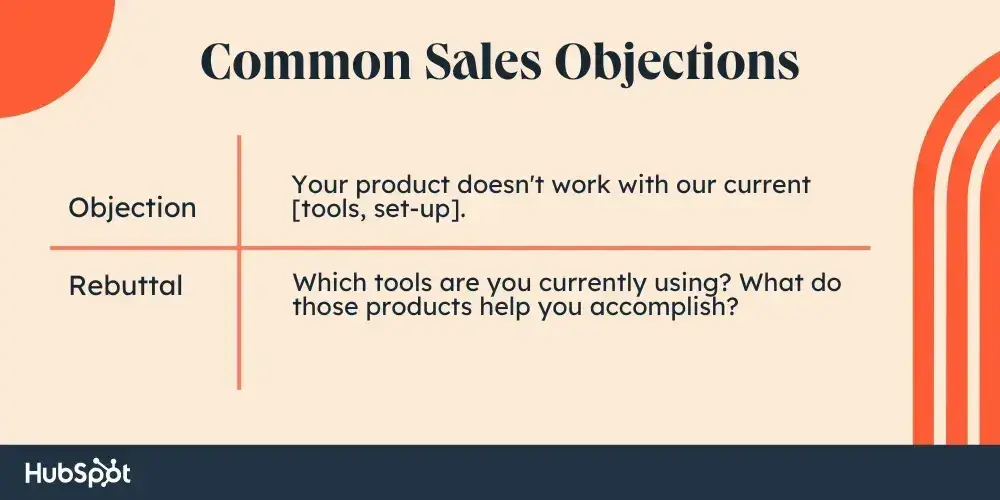
This objection can be a deal-breaker if the buyer is committed to their existing solutions. But sometimes, your product will replace these tools or make them obsolete. A workaround may be possible as well.
To find out, ask some questions.
Try responding this way:
“Which tools are you currently using? How integral are those tools to your [strategy]? What do you like and dislike about your existing platform?”
33. “Your product sounds great, but I'm too swamped right now to handle [implementation, roll-out].”
Prospects are often put off by the effort required to switch products, even if the ROI is substantial.
To empathize with them, prove that you're trustworthy, and ensure they do have the bandwidth. Next, combat their reluctance to change by digging into the costs or pains of their current situation.
Calculate what they stand to gain — in time, efficiency, money, or all of the above.
Try responding this way:
“I understand. It typically takes our customers [X days/weeks] to get fully up and running with [product]. How many minutes a day do you spend on [task]?”
Sales Objections That Are Actually Brush-Offs
34. “*Click.*”
If your prospect hangs up on you, don't sweat it — it happens to everyone eventually. Try reaching out to a different person at the company using a different approach.
Or you can go on the offensive. Wait a few seconds, then call back. Which approach you choose is purely dependent on how your conversation with your prospect went before the hang-up.
Try responding this way:
“Sorry, looks like we got disconnected! Do you have a few minutes?”
35. “I'm busy right now.”
Of course your prospect is busy — almost every professional is these days. Simply explain that you're not looking for a full-blown conversation, just a quick chat about whether or not a longer discussion about your product would be a good fit at their organization.
Try responding this way:
“I don't want to take up too much of your time. Can we have a quick chat about your challenges with X and how [product] may help?”
36. “I'm not interested.”
During a prospecting call, it’s far too early for a prospect to be able to definitively say they are or aren’t interested in your product.
Try responding this way:
I liked to respond with, “Some of our clients weren’t initially interested either, but when I showed them they could realize (X benefit), they changed their mind. Can your business afford to pass up on this opportunity without taking some time to explore the possibilities?”
37. “Just send me some information.”
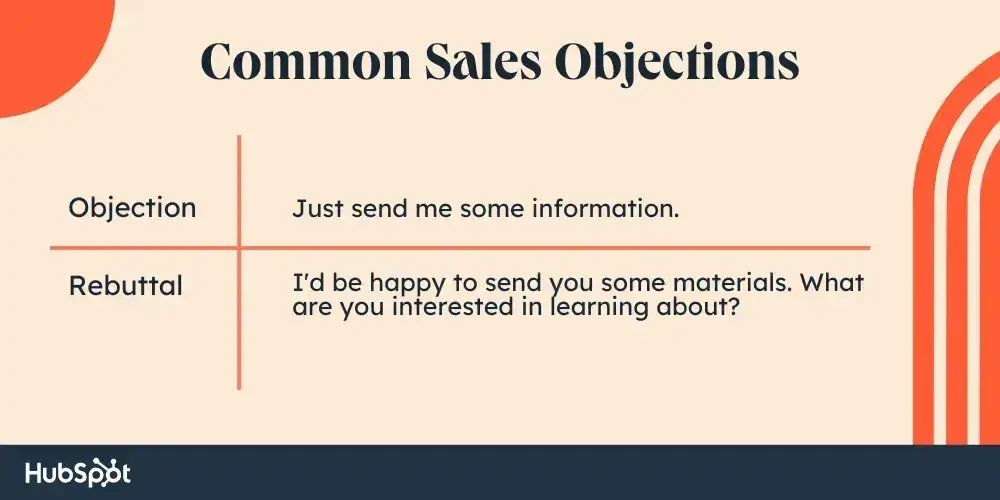
This is a great opportunity to segue into some qualification questions.
Try responding this way:
“I‘d be happy to send you some materials, but I want to make sure that they’re relevant to you. What are you interested in learning about?”
38. “Call me back next quarter.”
Prospects will often say this to dissuade you from pursuing a conversation. But don‘t let them off that easily — it’s a vague brush-off uttered in the hopes you'll fade away and disappear. Ask some questions to find out their motivations for brushing you off.
Try responding this way:
“I‘ll touch base next quarter. Before we hang up, I’d love to get a sense of how your next quarter will go. Do you feel you'll get the go-ahead from your superiors?”
39. “How did you get my information?”
Hopefully, you‘re not pulling numbers from lists you got off the internet — because if you are, your prospects have every reason to be annoyed.
Don’t get defensive — simply remind the prospect that they filled out a form on your site, or signed up for more information at a trade show, or that you simply came across their website and wanted to connect to see if you could help.
Try responding this way:
“I came across your website in my research and believe that [product] would be a great fit for you.”
40. “I hate you.”
Generally, prospects won‘t actually come right out and say this, but if you and your prospect really just don't get along, consider handing them off to a colleague, lest your company lose the deal for good. The upside? This objection has nothing to do with your product or its value.
Try responding this way:
“I'm sorry you feel that way. Can I introduce you to my colleague [name] to continue the conversation? She is very knowledgeable about how businesses like yours can [overcome the kinds of challenges/achieve the goals] that we discussed, and she has great relationships with executives like yourself.”
If the prospect isn’t willing to work with your colleague, their underlying objection is really not about you. Talk to your manager or colleagues about the best way forward.
41. “I'm not responsible for making these decisions.”
This common objection signals that a prospect doesn’t have (or doesn’t believe they have) the authority to discuss their company’s business challenges. Nor do they want to get involved in a sales cycle where they feel pressured to make decisions above their pay grade.
Try responding this way:
“Thanks [Name], for letting me know that you don’t have decision-making authority pertaining to purchasing decisions. Who on your team handles these types of decisions? Can you introduce me to them, or could you and I have a preliminary, no-pressure conversation? I think [solution] could help your team [achieve a defined benefit] by partnering with my company.
42. “Does your product do X, Y, and Z?”
This is one of the most common obstacles that prevent an SDR from converting the lead to an SQL. The good news is this generally means the prospect is interested. Use this opportunity to end the conversation on a good note and set up another appointment to discuss it.
Try responding this way:
“I am glad you asked that. I think it will be helpful to set up a time when we can answer this question and others with a specialist. When is a good day and time for us to talk?”
43. “Sorry, I have to cancel. I'll get back to you with a better time.”
People don't like to say “No” — and that includes your prospects. This manifests in ghosting, procrastination, and asking for more time.
Sales Pro Mike Rogewitz swears by Sandler's Negative Reverse Selling strategy to overcome tricky non-objection objections like these. “You want to call out your prospect‘s lack of interest and get them to admit the answer is ’No' without going too negative,” says Rogewitz.
Try responding this way:
“Typically, when someone cancels and says they‘ll get back to me, it means they’re just not interested in what I have to offer right now. Is it fair for me to assume that's the case?”
44. “Hello, you‘ve reached [Prospect’s Name] ... ”
Does your prospect avoid your phone calls like the plague? Do they take a while to get back to you and always need approval? Do they give vague answers when you ask about budget and priorities for the year?
If you answered “Yes” to any of these questions, you might be speaking with an individual contributor. They’re usually not as comfortable talking on the phone as managers or decision-makers, they need a lot of internal approval, and they aren’t privy to important budgetary information or company-wide priorities.
It’s important to gain the gatekeeper’s trust and learn as much as you can from them, but then you need to move on and build relationships with the people in the company who can actually choose your product or service.
Try responding this way:
- “Have you ever purchased this type of product or service before?”
- “Who will be in charge of this buying process?”
- “Who else should we bring on board for this conversation?”
Objection Handling Training
If you want to improve your team’s objection-handling skills, consider sales training programs or guides. Here are a few objection-handling training programs to give your sales team a leg up.
1. HubSpot’s Objection Handling Templates
This free guide goes over the why and how behind objection handling. Not only does it explain data-backed behaviors top sellers use to push back with buyers, but it also includes scripts for how to handle the most common sales objections, and these templates offer a goldmine of sales expertise.
2. Sell It
Founded by one of the top real estate agents in the country, Ryan Serhant, Sell It is a sales training and membership platform. You don’t need to be in real estate to benefit from the sales lessons shared on the platform. The resources are geared toward all types of business owners and entrepreneurs — anyone who sells, which applies to many professionals.
3. Challenger
Research shows that 38% of B2B purchases end up in no decision. That’s where Challenger can help. Challenger is an online sales training program that offers courses and playbooks for every step of the sales process. Sales teams can tap into the platform’s B2B expertise for objection handling training and more skills that they can apply to real-life deals.
When an Objection is a Firm “No”
Some prospects won’t give you a chance to explain the value that you can provide. They are too busy and have too little faith in the hordes of SDRs and sales reps that contact them on a daily basis. This means as a salesperson, you have to be creatively persistent. Suggest ways of continuing the dialog at a time that works
That said, at a certain point, “no” means “no.” The responses to the common objections above give you a way to pierce through the reactionary objections prospects give without thinking. If you or your sales team overcome all of a prospect’s objections and they still aren’t willing to invest their time with you, it’s sign they’re a poor fit.
Rule of thumb: If the prospect says an objection twice, it's real. No means no.
Overcoming Objections Can Become Your Best Sales Skill
As a sales professional, you’ll hear “no” a lot more than you hear “yes” —but overcoming a no can be more fun than an easy yes. Every no is a step toward helping prospects realize opportunities they never knew existed, and solving problems with your products or services.
Objection handling helps you learn how to get to the root of your prospects’ issues. With a little assistance, you can lead with empathy and understand where most objections are coming from. If you read these interactions right, you’ll be in a good position to handle any objection that comes up.
Editor's note: This post was originally published in September 2015 and has been updated for comprehensiveness.
Objection Handling


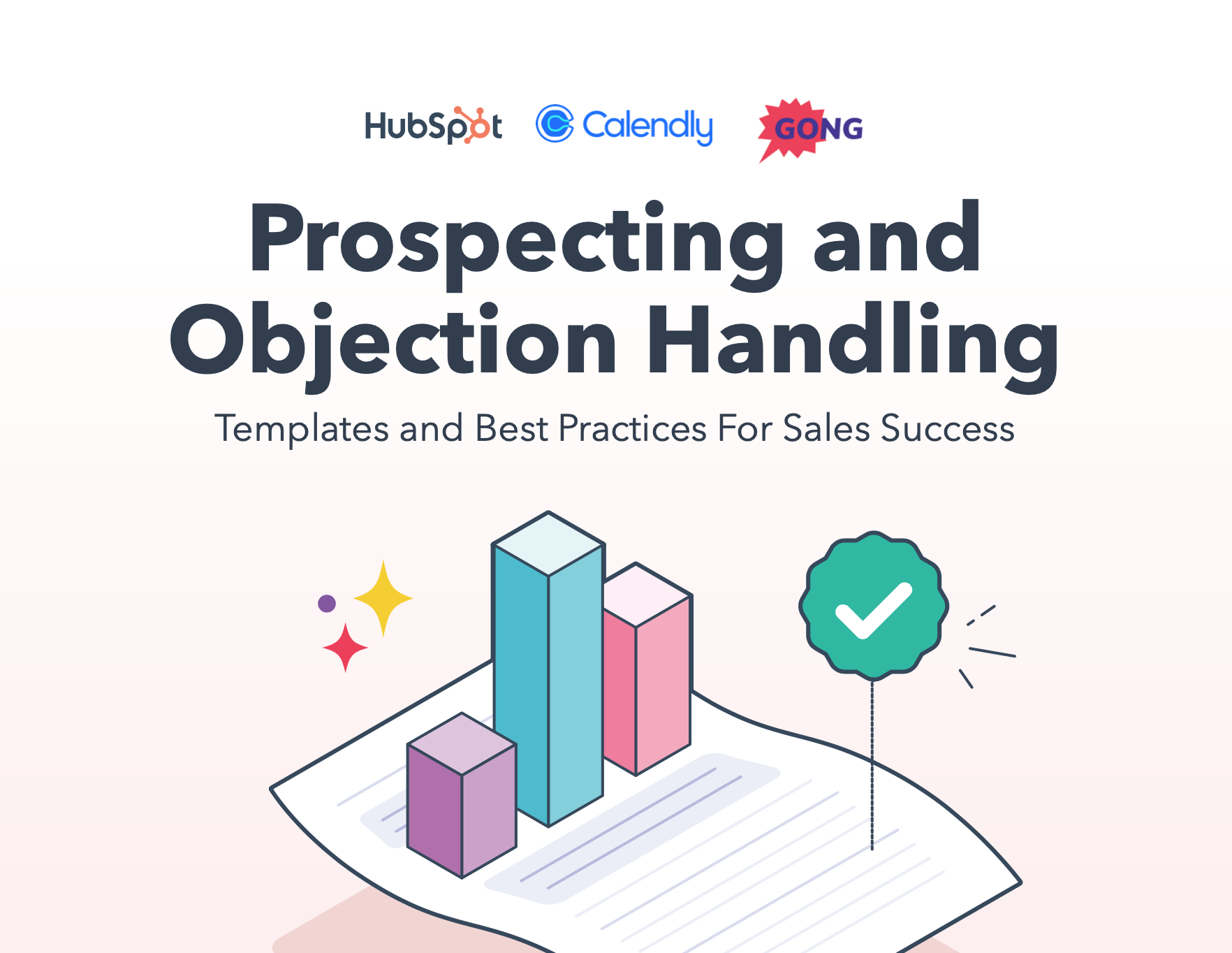




.jpg)




